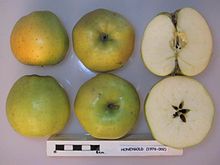
Golden Delicious is a cultivar of apple. It is one of the 15 most popular apple cultivars in the United States. It is not closely related to Red Delicious.

Red Delicious is a type of apple with a red exterior and sweet taste that was first recognized in Madison County, Iowa, in 1872. Today, the name Red Delicious comprises more than 50 cultivars. It was the most produced cultivar in the United States from 1968 to 2018, when it was surpassed by Gala.

The Haralson is a cultivar of apple that is medium-sized and has a round-conic shape.
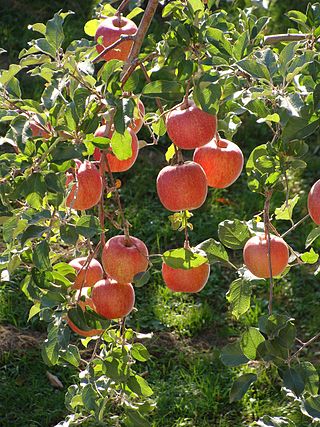
The Fuji apple is an apple cultivar developed by growers at the Tōhoku Research Station of the Ministry of Agriculture and Forestry in Fujisaki, Aomori, Japan, in the late 1930s, and brought to market in 1962. It originated as a cross between two American apple varieties—the Red Delicious and old Virginia Ralls Janet apples. According to the US Apple Association website it is one of the nine most popular apple cultivars in the United States. Its name is derived from the first part of the town where it was developed: Fujisaki.

Gala is an apple cultivar with a sweet, mild flavour, a crisp but not hard texture, and a striped or mottled orange or reddish appearance. Originating from New Zealand in the 1930s, similar to most named apples, it is clonally propagated. In 2018, it surpassed Red Delicious as the apple cultivar with the highest production in the United States, according to the US Apple Association. It was the first time in over 50 years that any cultivar was produced more than Red Delicious.

Honeycrisp is an apple cultivar developed at the Minnesota Agricultural Experiment Station's Horticultural Research Center at the University of Minnesota, Twin Cities. Designated in 1974 with the MN 1711 test designation, patented in 1988, and released in 1991, the Honeycrisp, once slated to be discarded, has rapidly become a prized commercial commodity, as its sweetness, firmness, and tartness make it an ideal apple for eating raw. "...The apple wasn't bred to grow, store or ship well. It was bred for taste: crisp, with balanced sweetness and acidity." It has larger cells than most apple cultivars, a trait which is correlated with juiciness, as larger cells are more prone to rupturing instead of cleaving along the cell walls; this rupturing effect is likely what makes the apple taste juicier. The Honeycrisp also retains its pigment well and has a relatively long shelf life when stored in cool, dry conditions. Pepin Heights Orchards delivered the first Honeycrisp apples to grocery stores in 1997. The name Honeycrisp was trademarked by the University of Minnesota, but university officials were unsure of its protection status in 2007. It is now the official state fruit of Minnesota. A large-sized honeycrisp will contain about 113 calories.
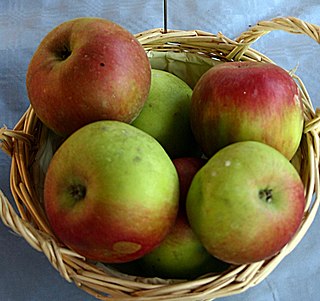
Idared is a type of apple cultivar from Moscow, Idaho, United States. Variety is characterized by a non-uniform skin color.
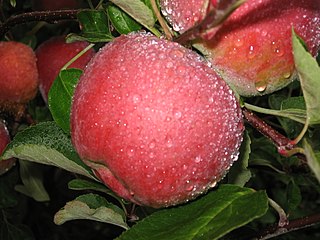
'Macoun' apples are a cross between the 'McIntosh' and 'Jersey Black' cultivars. The Macoun was developed at the New York State Agricultural Experiment Station in Geneva, by Richard Wellington. It was first introduced in 1932, and is an eating apple. This apple is popular for making European style apple pies because it does not break down during cooking and remains firm. Macouns are also very popular at roadside stands and pick-your-own farms. Availability is generally October through November.

Peter Gideon (1820–1899) was a farmer near Excelsior, Minnesota, United States, who was responsible for breeding apples that could withstand Minnesota's climate. Gideon's farmhouse, now within the boundaries of Shorewood, Minnesota, is listed on the National Register of Historic Places.
Table apples are a group of apple cultivars grown for eating raw as opposed to cooking or cidermaking. Table apples are usually sweet and the most prized exhibit particular aroma variations that differentiate them from other apples. D = Dual purpose

The Zestar! apple or Minnewashta (cultivar) is an apple cultivar released in 1999. It was developed by the horticulturalists at the Minnesota Landscape Arboretum's Horticultural Resource Center, at the University of Minnesota.
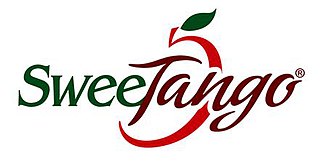
SweeTango is the brand name of the cultivated apple 'Minneiska'. It is a cross between the 'Honeycrisp' and the Zestar Apple belonging to the University of Minnesota. The apple is controlled and regulated for marketing, allowing only exclusive territories for growing. It has a sweet-tart taste that some food writers have described as something between brown sugar and spiced apple cider.

The Wealthy is an American apple cultivar, and was the earliest to thrive in the Minnesota climate. Horticulturalist Peter Gideon grew it after years of trial and error with various apple varieties, and the fruit was described in 1869.
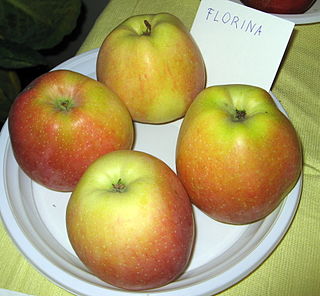
Florina which is also called Querina, is a French cultivar of domesticated apple, that has combined traits of the Jonathan, Golden Delicious and Rome apples, and was developed in Angers, France, by the "Station de Recherches d'Arboriculture Fruitiere". Although developed in France its ancestry is entirely American.

Dorsett Golden is a 'Golden Delicious'-like cultivar of domesticated apple and is descended from it, but is different with that it is early season, and most importantly, it needs a lower amount of cold weather to go into blooming, so it is possible to grow in warm climates.
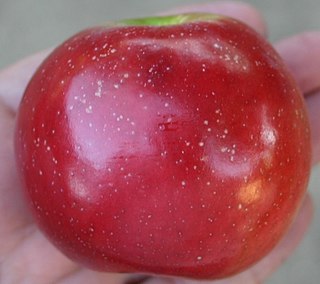
Enterprise is a modern bred, late-ripening and attractive, red cultivar of domesticated apple with excellent fruit quality combined with disease resistance to scab, cedar apple rust, fire blight and some resistance to powdery mildew. The fruit is large and attractive and retains excellent fresh quality for up to six months at 1°C. Its moderate acidity at time of harvest mellows in storage, and it is best after one month of storage.

Splendour, Splendor or Starksplendor is a modern cultivar of domesticated apple which was developed in New Zealand, and is regarded there as a popular commercial dessert apple. It has been said to be a cross between 'Red Dougherty' and 'Golden Delicious', but genetic analysis has not definitely characterized either of the parent cultivars, and records do not indicate known or suspected parents.

SugarBee (CN121) is an apple cultivar grown in the elevated orchards of Washington state. The variety was discovered by Chuck Nystrom in the early 1990s and developed in Minnesota, and is believed to be the result of an accidental cross-pollination between a Honeycrisp and another, unknown variety. Today, SugarBee has worldwide propagation rights held by Regal Fruit International and is licensed to Gebbers Farms and the Chelan Fruit Cooperative in Washington to produce the variety in the United States.

The MN55 cultivar apple developed by David Bedford, a senior researcher and research pomologist at the University of Minnesota's apple-breeding program, and James Luby, PhD, professor, Department of Horticultural Sciences, Horticultural Research Center, is a cross between Honeycrisp and MonArk (AA44), a non-patented apple variety grown in Arkansas.
EverCrisp is an American apple cultivar developed by the Midwest Apple Improvement Association (MAIA). Trademarked as EverCrisp, the MAIA-1 variety is a cross between two existing apple cultivars: the Honeycrisp and Fuji. Originally produced in Ohio, EverCrisp has since expanded to apple-growing regions across the Midwest in Michigan, Illinois and Indiana, in the Northeast in Pennsylvania and New York, and in the Northwest in Washington. The apple entered the public marketplace in 2017.
